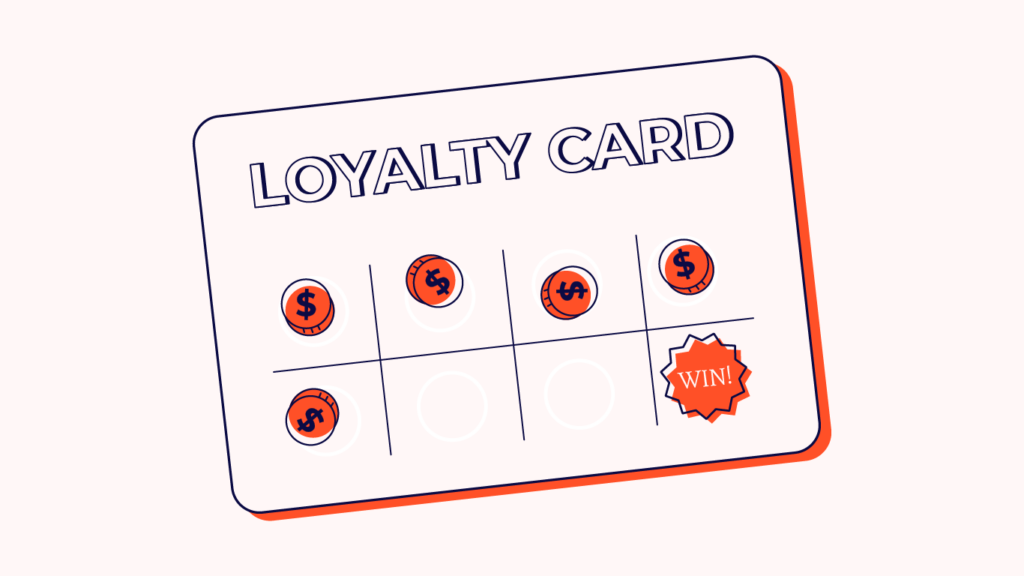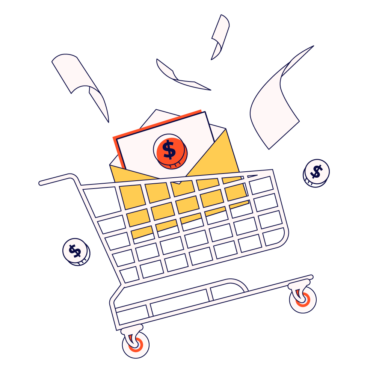Love Begets Loyalty: Ecommerce loyalty programs significantly reduce customer churn by rewarding repeat purchases, fostering brand loyalty, and possibly lessening the need for new customer acquisition.
Spend More, Smile More: Members of loyalty programs tend to spend 67% more than non-members, showcasing the financial benefits of nurturing a committed customer base through well-structured loyalty incentives.
Word-of-Mouth Wonders: Loyalty programs excel in organic marketing as satisfied members are more likely to recommend the brand to others, especially when incentivized, enhancing the brand's reputation and reach.
Perk Parade: Ecommerce loyalty programs offer diverse benefits to members, ranging from exclusive discounts to free shipping, highlighting the need for companies to tailor rewards that resonate with their specific audience.
Ecommerce loyalty programs are a great way to retain customers, keep them engaged with your brand, and increase revenue through repeat purchases.
If you’re struggling with customer retention, developing an appealing loyalty program is a proven way to grow your business in the long term.
There are financial benefits, too. Loyalty members spend 67% more than regular customers.
They are more likely to recommend your brand to friends and family—mostly due to incentives around making referrals (which we will get more into later), but also because customers love to talk about companies that do a great job of rewarding them for their brand loyalty with perks that matter to them.
Show your customers love and appreciation, and you’ll reap the rewards quickly.
What Are Ecommerce Loyalty Programs?
Ecommerce loyalty programs are a marketing strategy designed to minimize customer churn (or, said another way, boost customer retention), reward regular customers for their loyalty, and reduce reliance on new customer acquisition for sales growth.
Members of a brand’s loyalty program can get exclusive perks like special discounts, free shipping, exclusive members-only products, referral bonuses, points or credits to use toward future online shopping purchases, and more.
The perks of your loyalty program will depend on what will work best with your products and customer base. How you reward customers will depend on the type of loyalty program you implement.
So let’s talk about the types now.
What Are The Different Types Of Loyalty Programs?
There are many ways you can reward customers.
The most popular way to reward customers is through a points system, but there are also other ways to build loyalty, such as through paid subscriptions, tiered loyalty programs, and benefit programs.
Let’s look at each one a little closer in depth.
Point-based loyalty program
We’ve all heard about the Starbucks Rewards program.
Their mobile app is one of the most used apps for ordering coffee ahead of time and customizing your order. With every purchase, you accumulate stars which can be redeemed for drinks or food.
This point-based system keeps customers engaged with every purchase and gets them excited to spend in the pursuit of more rewards.
Ecommerce supplement brand Collagen Co also offers points for customers who engage and follow them on social media platforms, sign up for SMS messaging, and leave a review.

Paid loyalty rewards program (one-time and subscription)
One of the reasons why Amazon Prime is such a successful loyalty program is because they can provide you with an irresistible offer: that item you just ordered…what if you can get that by tomorrow?
Amazon is one of the few companies that can deliver on that promise without delays, and they know it.
Once you are ready to check out, they use their membership landing page to entice you with a free 30-day trial to test Prime benefits. A timely offer like that is hard to opt out of.
Currently, there are over 200 million Amazon Prime reward members around the globe, making it one of the most popular ecommerce customer loyalty programs.
63% of consumers pay for at least one loyalty program (which is often Amazon Prime), according to McKinsey.

Paid loyalty programs are successful because they drive members to follow up on that initial (or ongoing) investment. The members-only mentality changes customer behavior, increasing frequency of purchases, cart size, and affinity with the brand.
Tiered rewards program
Hierarchy is a fact of life. We all aim for ever higher tiers, striving to earn our way upward. So, it only makes sense that tiered loyalty programs would be a hit.
You can give certain customers the feeling that they are VIPs, or can be, by working their way up tiers and getting special rewards for their work.
There are over 17 million Sephora Beauty Insider reward members in North America alone.
Better yet, 80% of Sephora sales are due to their loyal members. Insider members can work their way up the tiers and become a “VIB” (Very Important Beauty Insider) and Rouge based on how much they spend online and in retail stores throughout the year.
Items in their rewards bazaar are updated twice a week, so there are always more new and exciting products and more reasons for you to visit Sephora.com, resulting in more repeat web traffic.

They also have a fantastic omnichannel commerce strategy in which their ecommerce site mirrors their retail spaces.
Benefits rewards program
Ikea’s family rewards program does not offer points with purchases but rather a few exclusive benefits instead.
Those who sign up for the program are given discounts, free coffee and tea, and other surprise perks throughout the year.
Referral program
While a bit different from the standard loyalty program, referral programs reward existing customers for bringing their friends, family, and people who they don’t really know but follow them on social media.
Much of the time, brands have loyalty programs and referral programs, so they can reap the rewards each program offers.
6 Ways Loyalty Programs Help Your Business
If you are wondering about how a loyalty program can benefit your ecommerce business, here are six reasons why creating a loyalty program is great for your bottom line.
1. Loyalty programs boost sales
If sales are slowing down and you aren’t getting a lot of web traffic, starting a loyalty program is a great customer retention tool to help boost sales to meet your monthly targets.
Reducing customer churn by just 5% can increase profitability by 75%. Not to mention the higher average order value and growth of new customers via referrals.
Setting up a loyalty program can take some time (we’ll review the types of programs available and the best options for you in a little bit), but it will pay off in the long run once you notice the order notifications pouring in.
Looking to boost sales for your ecommerce store? Here are some other proven marketing tactics worth checking out.
2. Loyalty programs build trust
Building customer loyalty is key when it comes to encouraging repeat purchases.
But it can also help you through the worst-case scenarios. With a recession looming and inflation rising, many brands are forced to bump prices due to supply chain issues and the rising cost of raw materials.
Cosmetic brands with a loyal fan base can deliver the bad news without prompting a major customer exodus.
When Rare Beauty announced a price hike due to manufacturing costs earlier this year, the customer response was mostly sympathetic rather than reactive.
We are all price sensitive, but building a rapport with your customer beforehand makes you more valuable in their eyes, and they will be less likely to break ties for a competing option.
3. Loyalty programs encourage social shares and referrals
You can tailor your ecommerce loyalty program to your needs.
If you want more mentions on social media, encourage your loyal customers to tag your brand or give you a shoutout on platforms like Facebook, Instagram, and TikTok in return for an incentive.
Or ask them to share a discount with their friends to get a kickback.
Happy, loyal customers will feel more compelled to mention your brand if they get a discount or gift with their next purchase.
And you will benefit majorly from word-of-mouth buzz.
4. Loyalty programs increase the customer lifetime value
Your customer lifetime value can be calculated by multiplying the average value of their past orders and multiplying it by the number of purchases they’ve made within a certain time frame.
This metric is a good gauge of whether or not customers' basket sizes are getting bigger after you’ve implemented a loyalty program and if they feel compelled to make repeat purchases.
Here’s one of the formulas you can use for your own ecommerce store:
Customer Lifetime Value (CLV) = Average Order Value x Orders x Time
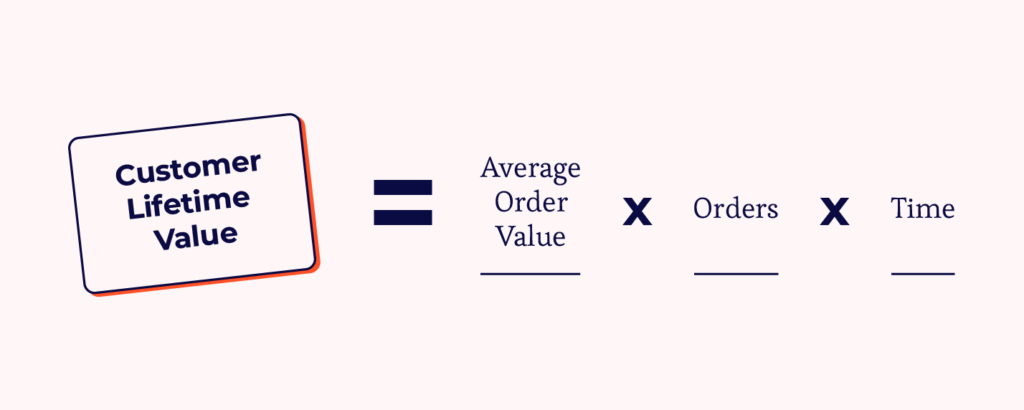
For example, if I ran an ecommerce site selling running shoes, I might see that one of my customers tends to purchase shoes twice a year, with an average order value of $100.
Their lifetime value would then be $200 a year. Suppose their customer lifetime value (CLV) goes up after I implement a loyalty program.
$200 = $100 x 2 x 1
In that case, that’s good news, and it means the incentives I've created are compelling enough to encourage either higher or more frequent orders.
For more ways to calculate your customer lifetime value and other ecommerce KPIs, check out this article here.
5. Loyalty programs build more robust customer profiles
When I worked for an organic skincare brand, we encountered a problem.
We wanted to launch a new antioxidant moisturizer for more mature skin, women in their 40s to 60s concerned about fine lines and wrinkles, and use email marketing as one of our main tactics.
However, there was no way to segment our emails since we’ve never captured data regarding the age range. All we had to go by was their name and email.
Setting up a loyalty program would have made it easier to capture this crucial detail.
In our sign-up process or as a short survey where a loyal customer could be awarded extra points or a GWP, we could have messaged our intended audience exclusively rather than send out a mass email.
Perhaps age isn’t a concern since you only offer one product that appeals exclusively to a specific market, but you never know what will happen as your business grows and expands its product line.
Knowing more about your customers will make segmentation and personalization a lot easier.
Therefore, the messaging hits home and converts an eager buyer rather than a bewildered one wondering why anti-aging cream targets someone still in their teens!
6. Loyalty programs save on customer acquisition costs
It costs 5x more to acquire new customers than to retain your current ones.
Rather than spending the majority of your budget trying to get new customers to your website, nurture the customers you already have who already know the brand and incentivize them to repurchase.
The only way to have a healthy ecommerce business is to have loyal repeat customers.
Not only that, but a healthy base of loyal customers will spread the love via word-of-mouth and referrals, thus driving acquisition of new customers at a lower cost.
How To Set Up Your Customer Loyalty Program In 8 Easy Steps
Now that we’ve covered what types of loyalty programs are available, here are some strategies to keep in mind before kickstarting your ecommerce loyalty program
1. Figure out why customers are loyal to you in the first place (or why they are not)
Ask yourself: Why are some of my customers driven to repeat orders while some make only a one-time purchase?
Ask your customers for feedback on what attracts them to your brand to uncover invaluable insight.
Perhaps they were attracted to your affordable pricing or brand humor to find out what’s the motivation behind their loyalty before building out your program.
This is also a good time to benchmark your conversion rates and set reasonable stretch goals for what you can achieve through your program.
2. Make your program easy to use and understand (and find!)
Nothing is more frustrating for a customer than signing up for a program and finding it difficult to redeem their points. Make it easy for them to understand how and when points can be redeemed.
If points expire, make it clear in your messaging so customers aren’t caught off guard.
As a best practice, build a designated landing page for your landing page so you can optimize it for SEO.
Some common customer search queries will be: “Your Brand Name” + loyalty program, so you want to make the page as easy to find as possible and show up high in the search rankings.
Add an FAQ section to your customer loyalty program landing page to make it crystal clear how the program works, its benefits, and any other questions your customer base may have.
3. Look at what your competitors are doing and offer something different
Chances are, your competitors already have or are thinking about creating a loyalty program themselves.
What can you do differently to set your brand apart? Aside from offering points, Summer Friday’s Self-Care Club rewards program offers members a birthday gift and a sweet discount upon signing up.
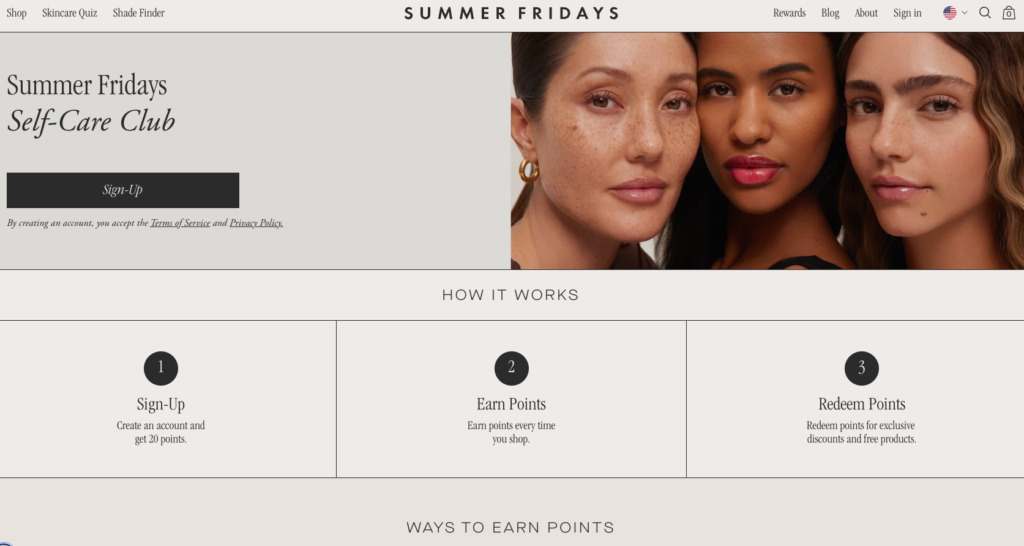
You can research the biggest names in your vertical to see the types of programs they employ, the language they use to describe the program, and the rewards they offer.
If it works for them, it could likely work for you as well.
Beyond that, look at your direct competitors and figure out how you can develop a loyalty program that is more compelling than theirs.
4. Customers should feel that rewards are attainable (hard to get but doable)
If you find customer engagement getting lower and lower month by month, one of the reasons may be that customers find it difficult to reach the goals you’ve set forth.
Let’s say you offer 20 points per purchase, and most customers only purchase your products monthly but need to accumulate 10,000 points for a 10% discount.
They might decide the program is not worth investing time and money into.
Make the reward hard to get but still attainable so the customer can reach that milestone quicker and get that boost of dopamine that associates your brand with a feel-good sensation.
5. Engage with customers outside of collecting points
While an ecommerce loyalty program exists to track a customer’s accumulation of points, there are other ways you can engage with customers outside of the point system. Here are some examples:
- Find out their birthday to send them a personalized message and gift.
- Provide them with early access to your new product launch.
- Invite them to an experiential pop-up.
There are certainly ways to do this that are particular to your vertical and your customers, so brainstorm! Add a more human touch to deepen the customer relationship.
6. Think omnichannel
Nowadays, there are various customer touchpoints to consider. Customers may begin their journey on your mobile website but end up making purchases via social media.
When choosing a loyalty program for your ecommerce site, make sure that it can track customers across different platforms. You can then analyze this data later on.
Wherever they are interacting with your brand, they should have a consistent experience.
Increasingly, customers are going online to buy something but picking it up in-store (referred to as BOPIS), so this same experience should be accessible with their rewards program.
7. Use AI to develop targeted offers
As artificial intelligence advances, you can elevate your loyalty program based on the information you are collecting now.
Segmenting customer profiles and delivering personalized messages will become easier and more efficient than ever as AI is integrated into more of the ecommerce tools we use.
Customer expect personalization from brands they shop with these days, with 76% more likely to purchase from brands that personalize.
The advancement of AI tech means that customer data can be used more intelligently to offer this sort of helpful personalization.
Investing more into a high-quality customer experience will undoubtedly result in a higher checkout rate.
8. Be flexible with your tactics
As the economic situation forces consumers to tighten their purse strings, cost savings are top of mind more than ever. So be flexible with how you reward customers.
Expedia restructured its loyalty program and renamed it One Key so customers can now earn and redeem points across their travel platforms, including Hotels.com, Vrbo, and Travelocity, providing customers with more choices when it comes to planning a budget-friendly vacation.
Regularly ask your customers about their program experience so you can adapt it for better customer experience and sales.
9 Ecommerce Loyalty Program Metrics For Tracking Your Growth
A loyalty program is only as good as the KPIs you track to measure your success. Let’s look at nine KPIs that can give you a good idea of whether your program is helping or hurting.
- Customer Lifetime Value (CLV): Measures the total revenue a business can expect from a single customer over the duration of their relationship.
- Formula: CLV = (Average Order Value × Purchase Frequency) × Average Customer Lifespan
- Customer Retention Rate: Indicates the percentage of customers who continue to do business with you over a given period.
- Formula: Customer Retention Rate = [(Number of Customers at End of Period - New Customers during Period) / Number of Customers at Start of Period] × 100
- Redemption Rate: Shows how frequently customers redeem their loyalty points or rewards.
- Formula: Redemption Rate = (Number of Rewards Redeemed / Number of Rewards Issued) × 100
- Customer Acquisition Cost (CAC): The total cost of acquiring a new customer.
- Formula: CAC = Total Marketing and Sales Costs / Number of New Customers Acquired
- Average Order Value (AOV): Reflects the average amount spent per order by customers.
- Formula: AOV = Total Revenue / Number of Orders
- Net Promoter Score (NPS): Measures customer satisfaction and loyalty, indicating how likely customers are to recommend your brand.
- Formula: NPS = % of Promoters (customers who score 9-10) - % of Detractors (customers who score 0-6)
- Repeat Customer Rate: The percentage of customers who have shopped more than once.
- Formula: Repeat Customer Rate = (Number of Repeat Customers / Total Number of Customers) × 100
- Active Engagement Rate (AER): Tracks how actively customers engage with your loyalty program.
- Formula: AER = (Number of Actively Engaging Customers / Total Number of Loyalty Program Members) × 100
- Customer Churn Rate: Measures the rate at which customers stop doing business with you.
- Formula: Customer Churn Rate = (Number of Customers Lost During Period / Number of Customers at Start of Period) × 100
Best Loyalty Program Tools: Plans And Pricing
Managing a loyalty program isn’t simple, which is why there are tons of great loyalty software to make it easy and intuitive.
In fact, the global loyalty management market was valued at $6.47 billion in 2023 and is projected to grow to $28.65 billion by 2030.
Here are some of the best ecommerce loyalty programs you can easily integrate into your Shopify store or website.
(Note: Prices shown below reflect basic plans offered. High-volume businesses and large enterprise pricing will vary.)
Yotpo
As one of the longest-running ecommerce loyalty programs, Yotpo offers a quick setup for building your ecommerce loyalty program.
With no coding required, you can easily drag and drop design elements to create a landing page for your loyalty program, choose what kind of redemptions you want to award customers and follow customers through every touch point, and track data through their analytics dashboard.
While a free plan is available, you’ll likely want to upgrade to their other plans as your business grows.
Price: Starting at $79/month

Smile
Smile’s ecommerce loyalty program allows your customers to accumulate points through purchases, social shares, and their birthdays. They can also set up a VIP program for your top loyal customers and a referral program.
Used by 100,000+ small businesses, this is a great way to test out a loyalty program at a low cost.
Price: Starting at $49/month
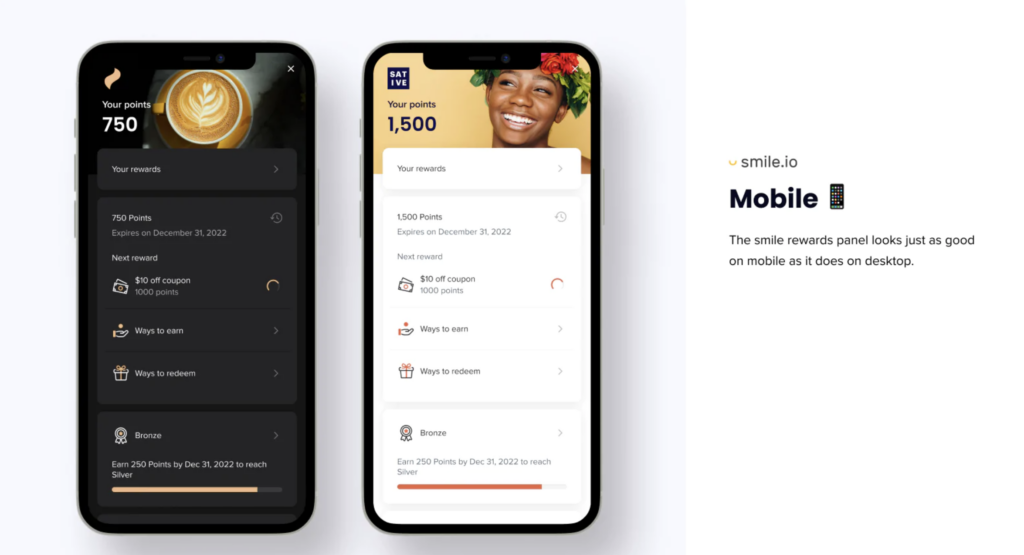
Joy
Joy is a great loyalty points app that can set you up quickly. With many five-star Shopify reviews, they are becoming a popular way to create a loyalty program quickly and affordably.
You can create a customized pop-up to encourage visitors to join your program, control membership status, and view your progress through their analytics dashboard.
If you encounter issues, their customer support team is quick and responsive.
Price: Starting at $35/month

ShopHub
ShopHub is a virtual stamp card that you can customize with your logo, brand colors, and desired stamp. You can choose when and how customers get awarded.
This is a great option for small businesses that want to reward customers without making too many tweaks. There’s also something charming about using a scratch card that will make it feel nostalgic for customers.
Price: $49/month

6 Ecommerce Loyalty Program Examples For Inspo
If you are looking to start a fancy new loyalty program, a little inspo from successful brands helps.
Newsweek recently put together their list of "America's Best Loyalty Programs" with the help of Statista, and you'll find some very familiar names there.

Whether you sell makeup, coffee, or a bit of everything, there’s a type of loyalty program for you.
Sephora Beauty Insider
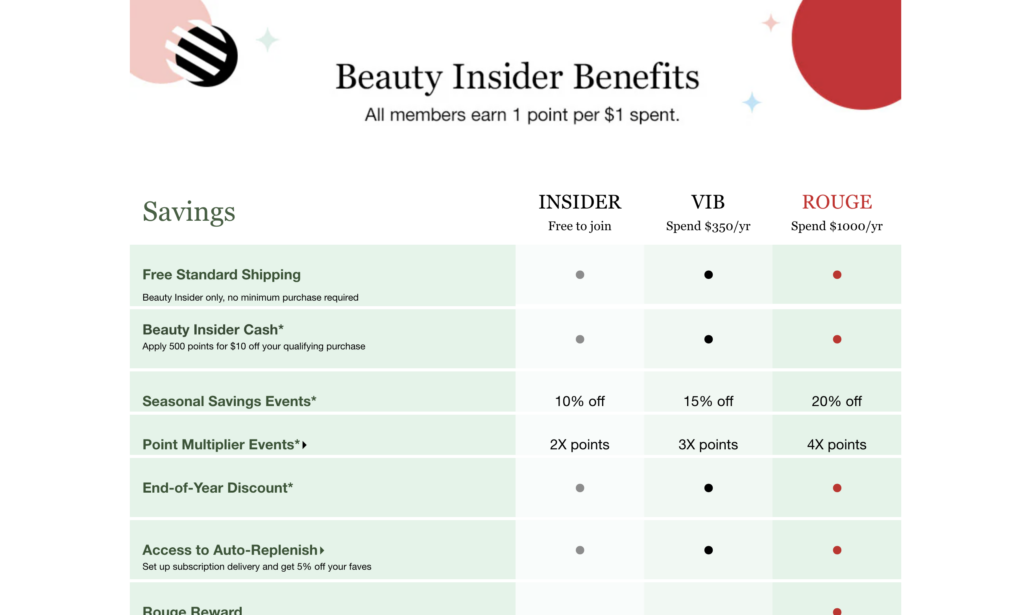
Sephora’s point-based Insider program includes numerous benefits like free standard shipping, cash off on purchases, seasonal event savings, end-of-year discounts, and more.
They also add a tiered element to this with their VIB and Rouge levels, accessed by spending a certain amount each year. These special spenders get bigger benefits, plus extra benefits only accessible to those tiers.
Starbucks Rewards
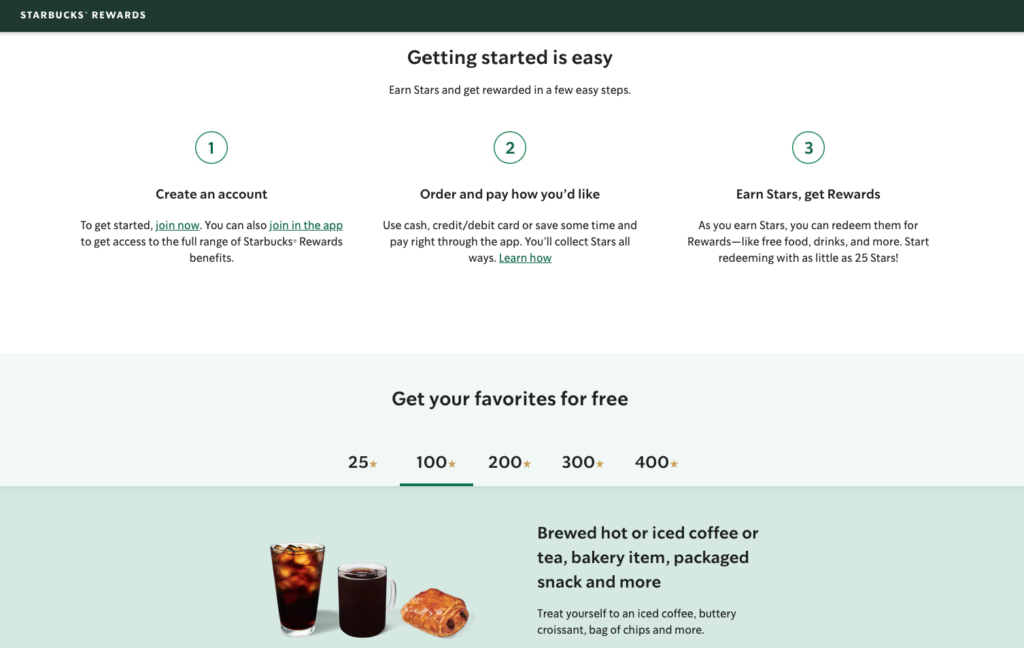
Their app-based rewards program makes it easy to order your coffee online while earning stars for drinks, food, and merchandise. Plus, they’ll give you a free treat on your birthday!
Amazon Prime

We all know Amazon Prime. Statistically, many of you reading this are members.
For a monthly or annual fee, you get free fast shipping on all Prime orders, access to Prime Video and Amazon Music for great movies, shows, music, and podcasts, and exclusive deals throughout the site.
Plus, with the Amazon Prime credit card, you get 5% cashback on Amazon and Whole Foods purchases.
e.l.f. Beauty Squad
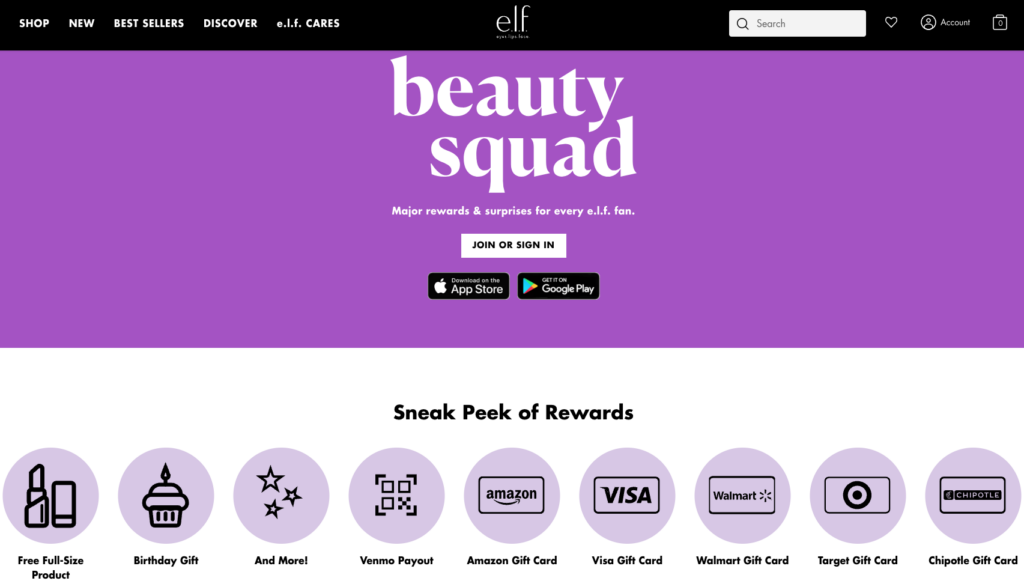
Similar to Sephora, e.l.f. uses a point-based program with tiers (Fan, Pro, and Icon). These give members rewards like early access, a birthday gift, members-only sales, free shipping, and more.
Target Circle
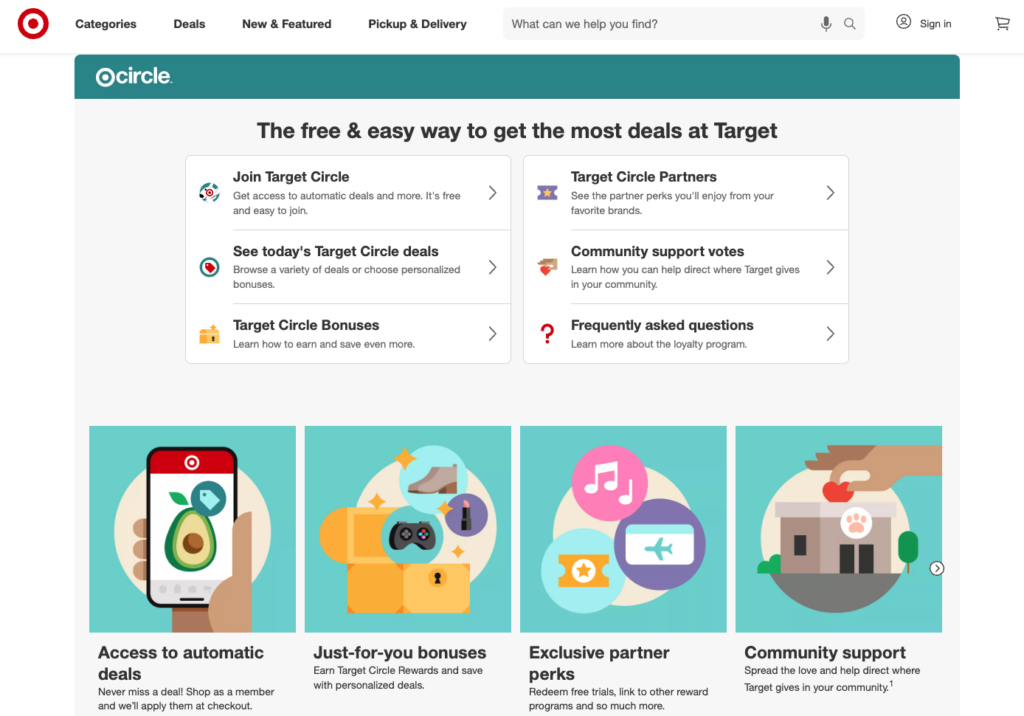
Target’s free loyalty program, Circle, gives members access to special deals, partner perks, and redeemable rewards points.
Like Amazon, they also have a credit card, which gives you a 5% discount on Target purchases and free 2-day shipping.
Sand Cloud

Towel brand Sand Cloud has many avenues for earning points, like how you can earn more tickets in a sweepstakes.
Points are earned through creating an account, following them on social media, writing product reviews, purchasing products, and celebrating your birthday. Redeem points for cash off future purchases.
On top of that, they have a VIP tier system (Silver, Gold, Diamond) that increases your reward points for birthdays and purchases.
Loyalty Programs Build Brand Trust And Retention—And Attract New Customers
Starting an ecommerce loyalty program is a great opportunity to capture more customer data that would benefit your business.
Retention is top of mind, of course. But it can also help shorten your new customer acquisition process and improve the ecommerce customer service pipeline.
If potential customers know there is a major draw for signing up for a loyalty program (receive a discount code to use for registering), there is more of an incentive to join.
And once you’ve built a rapport with your customer, you'll be rewarded with their loyalty and more frequent orders.
Don’t forget to subscribe to The Ecomm Manager newsletter to get more strategic insights for your ecommerce business.
Ecommerce Loyalty Programs FAQs
Now time for a little Q&A! Since we’re not doing this live, I’ll just throw out some questions and graciously answer them for you.
What challenges might I face when developing an ecommerce loyalty program?
Developing an ecommerce loyalty program involves multiple challenges, including balancing cost and benefits to offer appealing yet sustainable rewards.
You also need to personalize the program to diverse customer needs, which requires robust data analysis and integration with existing systems. The technical aspect is particularly challenging, as seamless integration ensures the program operates efficiently without disrupting the user experience.
How should I market my ecommerce loyalty program?
Effective marketing of your ecommerce loyalty program requires clear, simple messaging and utilization of multiple channels such as email, social media, and your website.
Communicating the benefits, highlighting exclusive rewards and personalized offers, and demonstrating how easy it is to earn and redeem points are crucial strategies.
Personalization in communication can double engagement rates, making the program more attractive and relevant to potential loyalty program members.
How effective are loyalty programs in increasing customer retention and sales?
Loyalty programs are highly effective in enhancing customer retention and boosting sales. They incentivize repeat business by providing a sense of value and belonging, which encourages customers to continue engaging with the brand.
This engagement often results in repeated purchases and increased spending, significantly impacting sales and customer loyalty.
How do loyalty programs impact customer behavior?
Loyalty programs deeply influence customer behavior by encouraging frequent purchases and higher spending, which can make customers prefer one brand over competitors.
These programs enhance customer satisfaction and perceived value through rewards, which not only fosters brand loyalty but also motivates customers to explore new products, thereby broadening their engagement with the brand.

